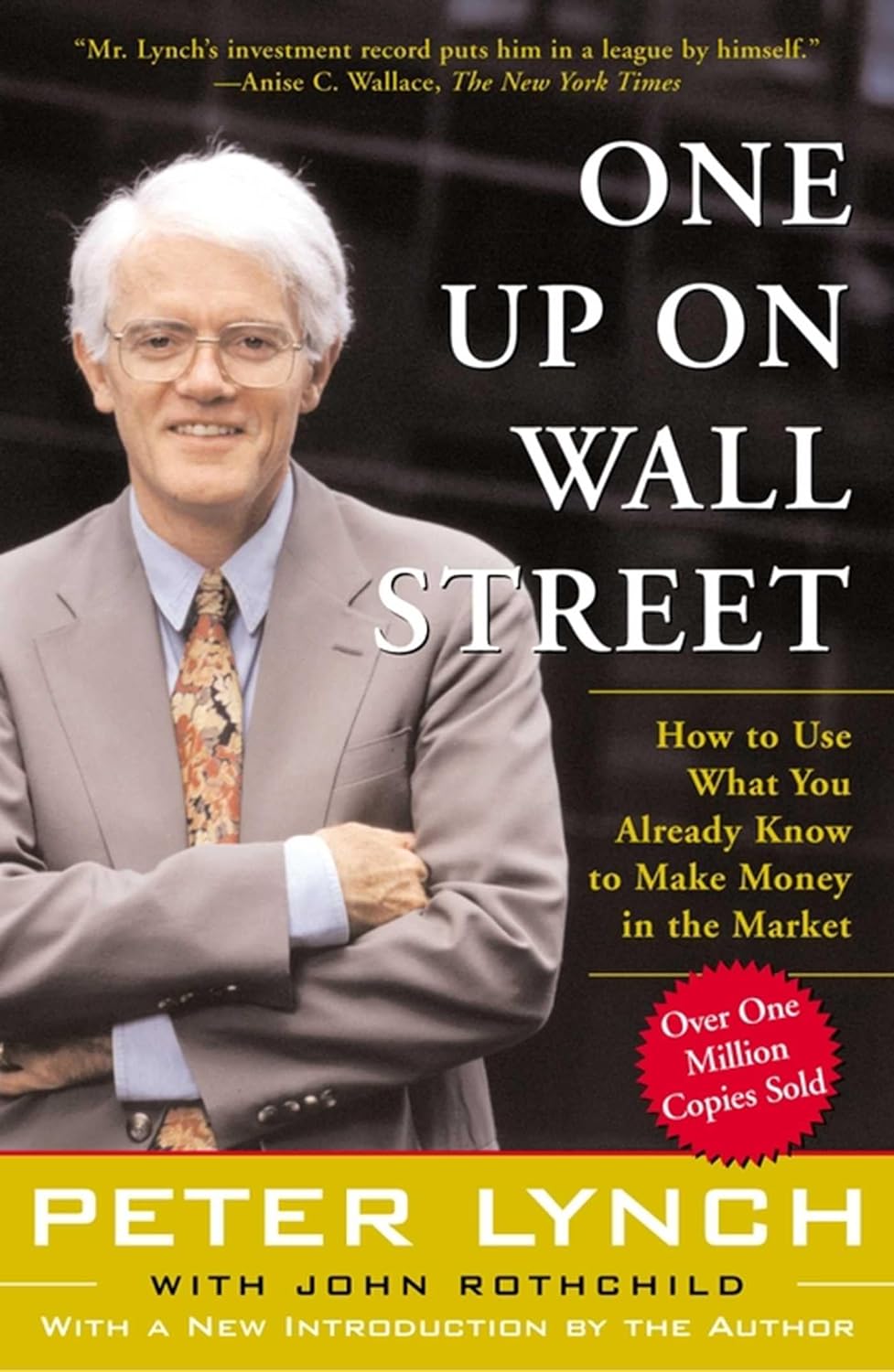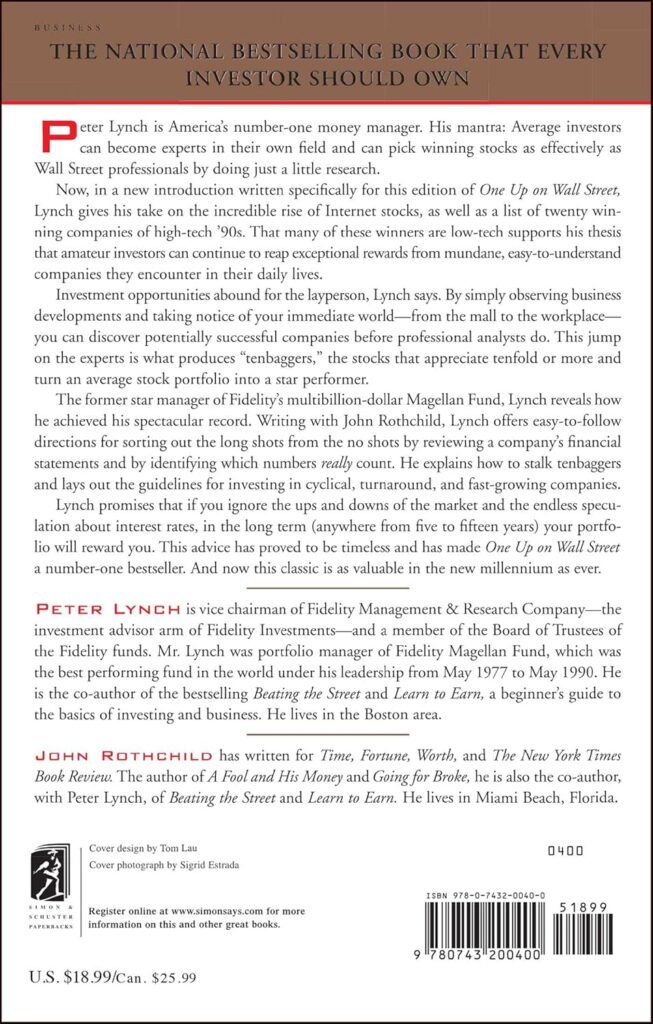
Peter Lynch’s One Up On Wall Street is a landmark investment book that combines practical wisdom with approachable storytelling. First published in 1989 and still widely regarded as essential reading for retail investors, it reflects the experience Lynch gained as the legendary fund manager of Fidelity Magellan Fund, which he grew from $18 million in assets to over $14 billion between 1977 and 1990.
The core premise of One Up On Wall Street is that average investors—using common sense, observation, and a little research—can outperform professional fund managers and the broader market.
This review explores Lynch’s main ideas, investment philosophy, types of stocks he identifies, practical advice for everyday investors, and the One Up On Wall Street’s long-term influence on both Wall Street and Main Street.
I. Lynch’s Central Philosophy: The Individual Investor Has the Edge
One of the most revolutionary ideas Lynch promotes in One Up On Wall Street is the belief that individual investors can beat the professionals by simply leveraging their own everyday experiences. He argues that ordinary people are constantly exposed to investment opportunities—in stores, restaurants, and their workplaces. If they pay attention to the products and services they and their communities like, they may spot growth opportunities before Wall Street analysts catch on.
For example, if a person notices a new retail chain opening stores and becoming increasingly popular, or hears from a teenager that a particular sneaker brand is all the rage, those observations might indicate a growing company worth investigating. Lynch argues that such “boots-on-the-ground” observations can give everyday people a crucial head start.
In this way, Lynch democratizes investing. He encourages people not to be intimidated by the complexity of financial markets. Instead of listening to headlines or analysts, investors should trust their own insights—provided they are willing to do some research and think long-term.
II. “Buy What You Know” — But Know What You’re Buying
While Lynch popularizes the mantra “buy what you know,” he’s careful to clarify that this does not mean investing blindly based on familiarity. Rather, familiarity should serve as a starting point for deeper analysis.
He emphasizes that an investor must “know what they own and why they own it.” This involves understanding the company’s business model, market potential, financial health, and long-term prospects. He critiques those who buy stocks based solely on tips, hunches, or short-term fads.
Lynch illustrates this with humorous anecdotes—such as a woman who bought a company’s stock because she liked its wallpaper—and warns against such careless investing. His message is clear: recognizing a good company in everyday life is the first step, not the final decision. Successful investing requires combining everyday insights with thoughtful analysis.
III. Six Categories of Stocks
To help investors better understand what they’re buying, Lynch introduces a system of classifying stocks into six types. This categorization is one of One Up On Wall Street’s most valuable contributions:
- Slow Growers
These are mature companies with modest earnings growth—typically 2–4% per year. They often pay high dividends and are best suited for conservative investors seeking income over growth. - Stalwarts
Large, established companies like Coca-Cola or Johnson & Johnson that grow moderately (around 10–12% annually). They can offer solid returns and hold up relatively well during downturns. - Fast Growers
These are Lynch’s favorites—small, rapidly expanding companies that can grow earnings at 20–25% annually. They offer the highest potential returns but also come with increased risk. - Cyclicals
Companies whose fortunes rise and fall with the economic cycle (e.g., airlines, automakers). Timing is crucial with cyclicals—buy low in recessions and sell high in booms. - Turnarounds
Troubled companies that are recovering. These “no-growers” may be losing money now, but if they survive, they can provide huge returns. This is high-risk territory. - Asset Plays
Stocks trading below the value of their assets—such as real estate, patents, or cash on hand. If the market eventually recognizes these hidden assets, the stock may surge.
By encouraging investors to understand which category a stock belongs to, Lynch helps them set more realistic expectations and better assess risk. For instance, a fast-growing tech stock should be judged differently than a slow-growing utility company.
IV. The Ten Golden Rules of Lynch Investing
Throughout One Up On Wall Street, Lynch returns to several rules and guidelines that distill his investment philosophy:
- Ignore the market noise. The economy, interest rates, and political events are impossible to predict consistently and should not dictate your investment strategy.
- Focus on companies, not the market. Stocks represent businesses. Invest based on the company’s prospects, not the market’s short-term mood.
- Look for simple stories. Lynch likes companies with easy-to-understand business models—he calls them “story stocks” and believes the best investments are those with clear, compelling narratives.
- Do your homework. Research is essential. Read annual reports, study financials, and ask tough questions.
- Be patient. Great companies need time to grow. Lynch held many of his best investments for years.
- Know why you bought it. Every stock purchase should have a clear rationale—whether it’s undervalued, a fast grower, or a turnaround.
- Don’t overreact to corrections. Lynch notes that stock declines are normal and often present buying opportunities.
- Avoid market timing. Trying to guess short-term market moves is futile. Instead, invest consistently.
- Use the “two-minute drill.” If you can’t explain why you own a stock in two minutes, you probably shouldn’t own it.
- Keep your emotions in check. Fear and greed are an investor’s worst enemies. Maintain a rational mindset.
These rules emphasize a blend of discipline, humility, and diligence—qualities Lynch believes are far more valuable than IQ when it comes to investing.
V. Case Studies: Learning from Lynch’s Winners
Lynch peppers One Up On Wall Street with real-world examples from his time managing the Magellan Fund. Some of his most successful investments were companies that the average investor might have come across in daily life—Dunkin’ Donuts, Hanes (maker of L’eggs pantyhose), and Subaru, to name a few.
He explains how he noticed the rise of Hanes through its success in department stores and how he identified Subaru’s potential as fuel-efficient cars became popular. These examples underscore his belief that successful investing doesn’t require advanced degrees or Wall Street access—just observation, common sense, and follow-through.
He also admits his mistakes and details the lessons learned. One example is his regret over investing in companies he didn’t fully understand or where he chased hype instead of substance.
VI. Common Pitfalls to Avoid
In One Up On Wall Street, Lynch also catalogs the common mistakes that lead investors astray:
- Chasing hot tips: Buying a stock based on hearsay, without understanding it.
- Overdiversification: Lynch believes in owning a manageable number of stocks—enough to diversify but not so many that one can’t track them.
- Focusing on short-term news: Quarterly earnings, analyst ratings, and media headlines often distract from a company’s long-term value.
- Forgetting the fundamentals: No matter how popular or promising a company seems, its underlying financials matter.
By avoiding these traps, investors can remain focused on finding and holding quality companies.
VII. Impact and Legacy
One Up On Wall Street remains one of the most widely recommended books for beginner and intermediate investors. Its influence can be seen in the “buy what you know” philosophy popularized in investing communities and social media today. It has inspired generations of investors to take control of their financial futures and to believe that they can do well—even without institutional backing.
Lynch’s approach has also aged remarkably well. While some of the examples in One Up On Wall Street are dated, the principles remain relevant in an age of algorithmic trading, meme stocks, and cryptocurrencies. The ideas of staying grounded, doing research, and keeping perspective are timeless.
Many modern value and growth investors owe a debt to Lynch’s accessible, pragmatic teachings.
.

Conclusion
Peter Lynch’s One Up On Wall Street is more than a book on stock picking—it’s a guide to rational, self-empowered investing. Through its mix of humor, humility, and hard-earned wisdom, Lynch makes a compelling case that successful investing is within reach for anyone who’s willing to observe, think, and learn.
By focusing on what one already knows, avoiding market hysteria, and committing to understanding the companies behind the stocks, investors can uncover opportunities others miss. Lynch doesn’t promise quick riches, but he does offer a reliable roadmap for building wealth over time.
For anyone serious about investing—whether novice or seasoned—One Up On Wall Street is required reading. Its lessons are as applicable in 2025 as they were in 1989, and its message is evergreen: Pay attention, do the work, and stay the course.
If you found this review useful please share it with friends and family and then check out some of our other Book Reviews.
.
